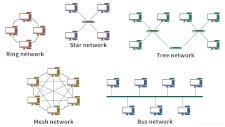Network Topology
Network topology describes the arrangement of nodes in a computer or communications network. It may refer to the physical topology of a network, which describes how each device physically connects to each other; it may also refer to a network's logical topology, which describes how data travels over a network between devices. Both physical and logical network topology affect the overall performance of a network, as well as how easy it is to expand and add new devices.
There are several common physical network topology designs used in modern networks, each with benefits and drawbacks. Several common examples are listed below:
- Star networks use a central node that connects to every other node on the network. All data travels through that central node (like a router or a switch), which analyzes each data packet and routes it to its destination. Star networks are also known as hub-and-spoke networks.
- Tree networks are a type of hybrid Star network. A Tree network starts with a central "root" node, which connects to the central nodes of several Star networks.
- Ring networks form a circle, connecting each node to two adjacent nodes. Data traveling over a ring hops from node to node until it reaches its destination.
- Line networks are similar to Ring networks, except that the endpoints do not connect and form a circle.
- Mesh networks provide direct connections between all of the network's nodes. Mesh networks are very resilient, since there's a lot of redundancy, but they are complex to manage and do not scale well to large sizes.
- Bus networks provide a single central cable, or "bus," as a backbone for the network. Each node connects to the bus and listens for data packets addressed to it.
While a network's physical topology is important, so is its logical topology — how data travels between devices and nodes over a network's physical connections. Network administrators can change a network's logical topology separately from its physical topology, allowing them to make changes without redesigning a network's infrastructure and moving network devices. For example, admins may create virtual networks to isolate certain devices from the rest of the network, even though the physical topology does not change.
 Test Your Knowledge
Test Your Knowledge